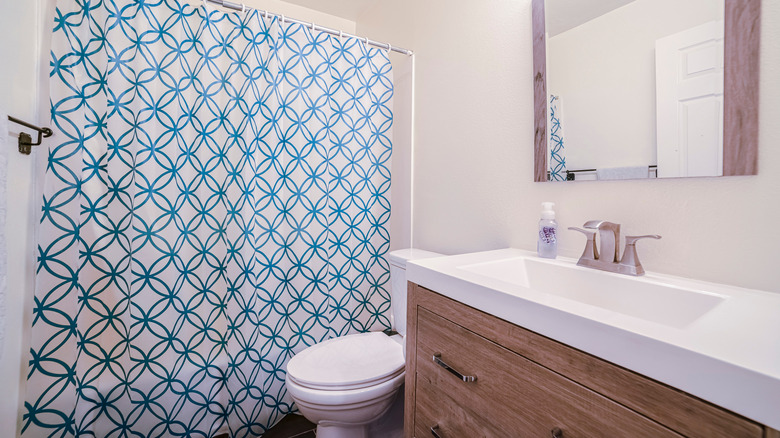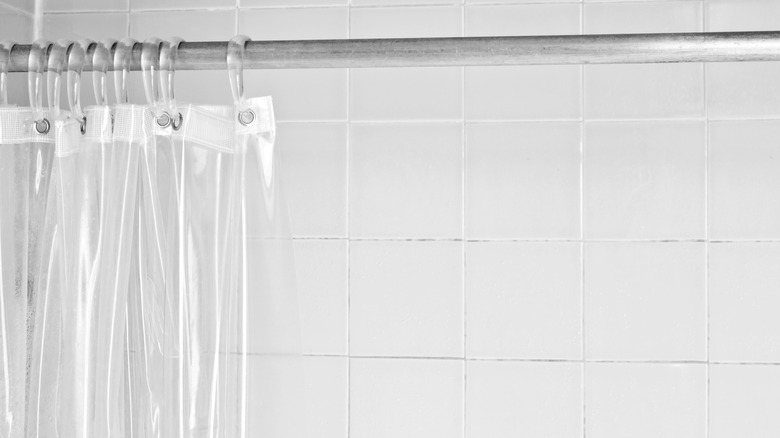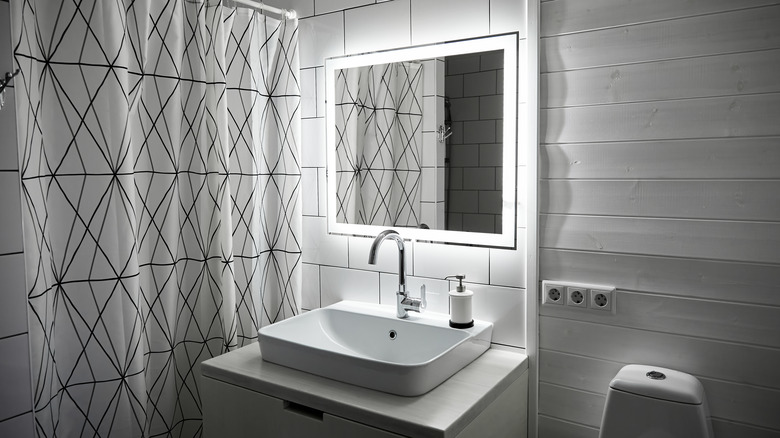Things You Should Consider When Picking Out A Shower Curtain
Whether your bathroom is your spa or a utilitarian convenience, you need a shower curtain that keeps water from splashing onto the floor. That's job one. After that, there's an infinite variety of choices including material, texture, finish, and color. When you're thinking about adding or changing this comparatively large item to decorate what's usually one of the smallest rooms in the house, we have a few ideas about where to start.
The right curtain can make your bathroom look bigger and we've looked into how stylish shower curtains can reflect your personal aesthetic, but before picking out a style or color, make sure the curtain does its job by keeping water droplets inside the shower. Also, if the curtain isn't waterproof, add a liner to keep the curtain dry and free of mold and mildew. Shower curtains come in a multitude of materials, from vinyl to fabric such as cotton or polyester, and newer materials like PEVA/EVA.
Materials matter
Fabric shower curtains tend to be water resistant, not waterproof. However, they are easy to keep clean, since they are usually machine washable. Check the package to be sure. Avoid the dryer, however. Simply rehang the washed curtain in the bathroom and allow it to air dry. Hung inside the shower, waterproof curtain liners made from vinyl or PVC (polyvinyl chloride) will keep water from splashing onto a fabric curtain. While liners are generally less expensive, when new, vinyl can outgas, giving off an unpleasant chemical odor.
Liners and curtains also now come in PEVA/EVA (polyethylene-vinyl acetate and ethylene-vinyl acetate) newer plastics that drape like fabric but are more eco-friendly than vinyl, since these materials do not have the same harsh chemicals as PVC. This makes them a greener, healthier option, especially for people with sensitivities. Vinyl, PCV, and PEVA/EVA should not be put in a washing machine. Instead, spray the inside with all-purpose household cleaner, allowing the excess to drip into the tub or shower, and rinse it off. Remember, too, that liners fall inside the tub during a shower, and the curtain should fall outside. There's also an option for weighted liners, to ensure the material stays in place.
Color, pattern, and style
After you've decided on the curtain and liner, pick your color and pattern. In general, a solid color gives the room a minimalist look and is a good option if you already have lots of decoration in the bathroom on the wallpaper, for example. Clear or white curtains will allow more light into the shower if that's important to you. However, if your entire bathroom is white on white, you may want another color or a pattern to enliven the space. Or, consider adding more white but add a texture to the mix as well. If you have a theme or style for your room, make sure the curtain goes with the flow. A big floral pattern in the middle of a calm beachy style may hit the wrong note. But, the same curtain in a shabby chic or bohemian décor may be the perfect focal point.
Don't forget hardware. This is the detail that can bring your bath from so-so to sophisticated. While some shower curtains have an industrial look of reinforced rings that hang with no hardware, most liners and curtains hang from rings that come in a huge assortment of colors, styles, and materials. When choosing rings, borrow a color or accent hue from the curtain itself. Similarly, metallic rings should complement the visual aesthetic of the curtain you've chosen. You can also have the rings match or contrast other fixtures in the bathroom including faucets, towel bars, cabinet knobs, or lighting.


